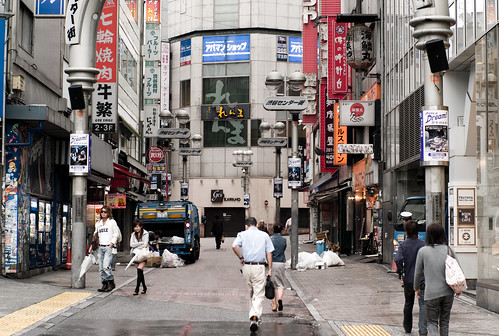Wireless Watch from Japan, Inc. has a story, “The Navigation Bubble,” about the mobile maps market in Japan. Not surprisingly, given the difficulty of specifying Tokyo addresses (which are usually not numbered linearly with the flow of the street, may not have names, and where locations are provided through neighborhood designations), map making is a well practiced endeavor, and the leading map company, Zenrin, has been in the forefront of expanding the use of locational products. (It is worth noting that Japanese mobile phones have rich, GPS-enabled locational and directional services).

Shibuya. Photo by Joi Ito 2007 (CC BY/2.0).
The Wireless Watch article states:
Japan has been leading the in-car navigation industry. Maps are a pure necessity in Japan – it is easy to get lost as streets have no names. Most of the vehicles nowadays are sold with high-end built-in navigation units of which the maps are supplied by leading mapmaker Zenrin, a Kyushu-based company.
At the Zenrin web site (the English version), it is eye-opening to read about the various product offerings. Obviously, the detail required to meet Japanese expectations is high:
Our detailed maps feature the names of each building and residence, as well as roads and traffic information such as street names, bus stops, traffic lights and one-way streets.
There is also evidently a degree of information centralization that would be difficult to achieve within the United States, or I suspect, most other states, where geo-reference information tends to remain viscously within vertical data application silos.
ZENRIN maps are widely used by local governments and public utility companies. We provide these bodies with diverse maps from fire department maps to electricity, gas, sewage and telecommunications maps that specify pertinent information. For example, the fire department maps clearly indicate the location of fire hydrants and storage facilities for dangerous materials.
This kind of intensely detailed mapping makes one contemplate the rich set of derivative applications that one might evolve, and definitely points the way to the deeper embedding of locational information in software-based knowledge systems.
It is intriguing to think about how the ready availability of this public infrastructure data could be integrated into newer conceptions of architectural design, engineering, and construction, such as Building Information Modeling, with attempts to integrate consolidated building information into other relevant datasets including utilities, First Responders, and so forth. The standards here are nascent and many, but there may be eventual clarification as the benefits are obvious and compelling (speaking as someone who was living on the southern edge of Greenwich Village in September 2001).
